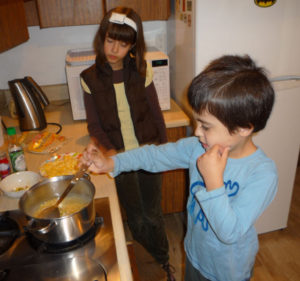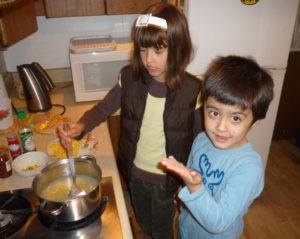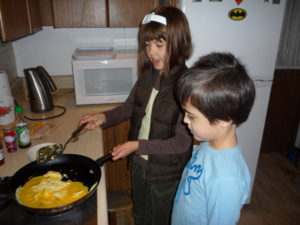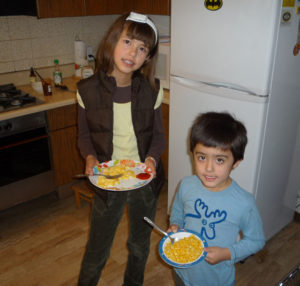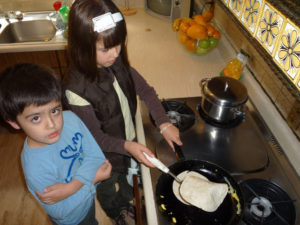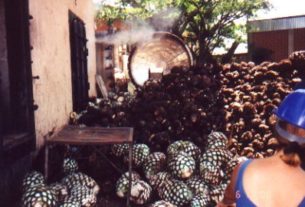Mexican Kitchen
With the month of June comes the start of the school vacation, long awaited by young students, but possibly not as much so by their mothers and fathers. Keeping the kids busy, happy and productive throughout the summer can be a challenge, especially for conscientious parents who continue to limit the TV and video hours to those followed during the school year.
The current economic crisis may present a few more constraints when it comes to vacation plans, possibly precluding summer camp, swimming lessons, and other seasonal activities. But, as they say, we all have to eat, and involving children with meal preparation, at least for a couple of meals a week, is a good way to provide them with an activity that is practical, teaches basic skills, gives a sense of accomplishment and, most of all, is fun. And Mexican food is a terrific place to start. I have never met a child who would turn down a taco.
As any Mexican cook knows, many of the same ingredients found in this cuisine can be used in a remarkable variety of ways. Tomatoes, avocados and other produce in season during the summer months make this a great time to develop an easy, delicious repertoire of Mexican dishes. And a tortilla presents a blank culinary canvas to fill, roll, stack, top, or cut up for chips.
Aside from using inexpensive ingredients, Mexican food is versatile. Many of its most popular dishes, such as quesadillas, tacos and enchiladas, are filled, and the filling can usually be anything on hand. Ground meat and poultry are easy fillings, and so is shredded leftover cooked meat or poultry. Cheese, beans, vegetables and even tofu are all possible fillings. This presents opportunities for children to get creative and to make choices that will give them a real sense of contributing to the menu.
These same ingredients can also be piled on tostadas. The baked versions of tostadas and chips are healthier by far than the fried ones, and give both kids and adults a chance to taste the real flavors of salsas, guacamole and other dips and toppings without the underlying taste of fat used in frying. A look at the fat content of fried chips, as compared with baked, is a real eye-opener.
And speaking of dips and toppings, fruit salsas, besides being healthy and seasonal, are perfect for practising knife skills, under adult supervision. Every child is different, and the adult who cooks with children will have to make individual decisions regarding when to introduce knife and stove skills. Most children’s cookbooks provide safety lessons and age and/or grade level guidelines. Some children’s Mexican cookbooks that do this, as well as presenting cultural information and basic Spanish cooking and ingredient vocabulary, are:
- Handstand Kids Mexican Cookbook by Yvette Garfield, published by Handstand Kids LLC, 2008. This book, for ages 5 and up, presents a colorful cast of multi-ethnic characters, reminiscent of the gang on Sesame Street, who lead kids through simple recipes that are graded on skill levels. Packaged in a tortilla bag and containing an oven mitt, it is a good choice for the youngest beginners.
- The Young Chef’s Mexican Cookbook by Karen Ward, published by Crabtree Publishing, 2001. This book presents fewer recipes, but with illustrated step-by step instructions and color photos. It is recommended for grades 4 and up, although it requires closer to 7th grade reading skills. There is some Spanish vocabulary, plus information on customs and traditions, and a section on Day of the Dead.
- The Cooking of Mexico International Cookbook for Kids by Matthew Locricchio, published by Benchmark Books, 2009. This is part of the SUPERCHEF series for young readers, introducing them to the cuisines of other countries and cultures. It is recommended for grades 7-12. The recipe categories range from soups and salsas to main dishes, taco fillings, vegetables, desserts and beverages. It goes beyond the beginner level in its presentation of different regional dishes, such as Veracruz style red snapper. Adults who enjoy cooking will appreciate not only the time shared with their children in the kitchen, but the recipes themselves.
- Cooking the Mexican Way by Rosa Coronado, published by Lerner Publishing Group, 2001. This is part of the Easy Menu ethnic cookbook series for young readers. Aimed at grades 5-8, it contains color photos, easy step-by-step directions, and a good selection of vegetarian and low fat options. There are sample menus, shopping lists and prep times, which means that older children can learn to plan meals and purchases.
Introducing children to cooking and kitchen skills is enriching for parents as well. Having children take part in an essential household function benefits the whole family, and knowing that your kids are learning a life skill makes the experience even more rewarding. In the beginning, set aside a day when you are not rushed to get dinner on the table, and have time and patience. Before you know it, your child will be carrying out many of the recipe steps without needing assistance.
Once you have used a cookbook together and established some kitchen safety guidelines, try a few of the recipes below, all of which are easy to prepare. I have used them with kids, and my own daughter was making most of them, often with friends and nearly always with her own variations, by the age of 12. Some children like food that is a bit on the picante side and some don’t, but most Mexican food is good either way.
- Bean smothered tortillas: Enfrijoladas
- Pasta salad with jalapeño vinaigrette: Coditos con salsa
- Mango salsa: Salsa de mango
- Custard Dessert: Natillas
- Watermelon water: Agua de sandia

